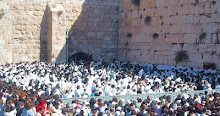Biblical Proof of Jeremiah Unearthed at Ancient City of David
A completely intact seal impression, or "bula", bearing the name Gedaliahu ben Pashur was uncovered. The bula is actually a stamped engraving made of mortar.
Gedaliahu ben Pashur's bula was found a bare few meters away from the site where a second such seal, this one belonging to Yuchal ben Shlemiyahu, an elder in the court of King Tzidkiyahu, was found three years ago, at the entrance to the City of David.
According to Professor Eilat Mazar of Jerusalem's Hebrew University, who led the dig, the ancient Hebrew letters "are very clearly preserved." The seal impression was found in clay, she said.
In the Book of Jeremiah (38:1-4), both men were ministers to King Tzidkiyahu, who reigned from 597-586 BCE. The two, along with another pair demanded the death penalty for the prophet Jeremiah in response to his plea for the king to surrender the city to the oncoming hordes of the Babylonian conqueror Nebuchadnezzer.
The team of archaeologists led by Mazar focused its efforts on the layer of artifacts from the First Temple period located just outside the walls of the Old City, near the Dung Gate.
The seal impression that was found three years ago was uncovered inside a stone structure that Mazar said she believed was the Palace of David. Gedaliahu's seal impression was unearthed at the foot of the external wall of the same structure, under a tower that appeared to have been built in the days of Nechemia in the fifth century BCE.
Mazar has been excavating the site since 2005. She is a senior fellow at the Shalem Center, a Jerusalem-based research and educational institute, and heads its Institute of Archaeology. The Ir David (City of David) Foundation was the principal sponsor of the excavation, together with the Israel Antiquities Authority, the Hebrew University, and the Shalem Center.









No comments:
Post a Comment